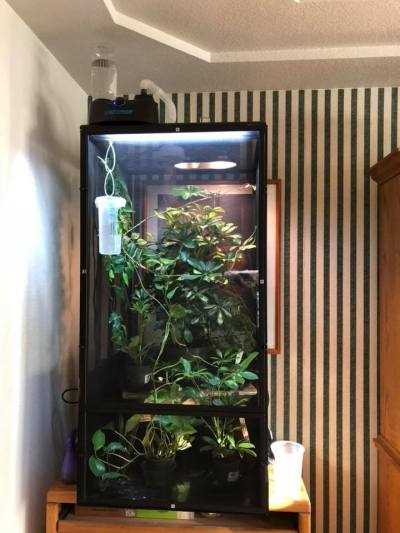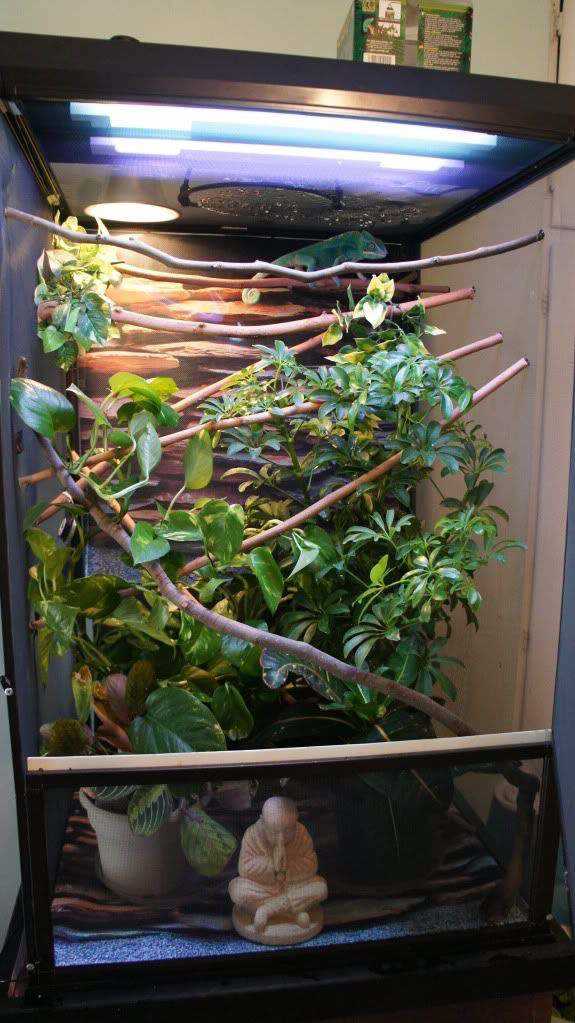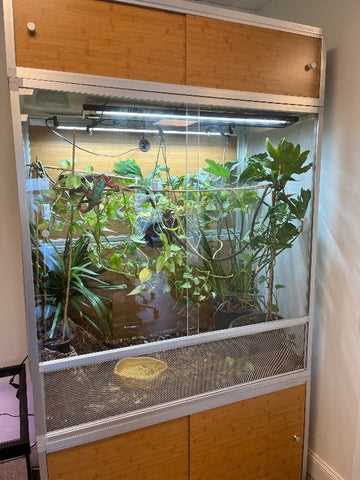
Chameleons are arboreal reptiles, which means they spend the majority of their time in trees and shrubs. Therefore, it is essential to choose a tank that provides enough vertical space for your chameleon to climb and explore. Opting for a tall tank rather than a wide one is generally recommended to mimic their natural habitat.
For juvenile chameleons, a smaller tank is suitable to prevent them from feeling overwhelmed in a large space. A tank size of about 16x16x30 inches is often appropriate for young chameleons, allowing them to move around comfortably while still feeling secure.
As your chameleon grows into adulthood, you will need to upgrade to a larger tank to accommodate their increased size and activity. Adult chameleons typically require an enclosure with dimensions of 24x24x48 inches or larger, providing ample space for them to climb, bask, and hunt.
1. Space for Movement: Chameleons are arboreal creatures that love to climb, explore, and move around. Inadequate tank size can restrict their natural movements, causing stress and physical discomfort. A spacious tank allows chameleons to exercise, perch, and roam freely, promoting their overall physical and mental well-being.
3. Temperature Regulation: Chameleons are ectothermic creatures, meaning they rely on external sources to regulate their body temperature. A correctly sized tank allows for the placement of heating and lighting equipment at appropriate distances, creating temperature gradients within the enclosure. This gradient ensures that your chameleon can easily move to areas with the desired temperature and thermoregulate effectively.
5. Behavioral Stimulation: Chameleons are intelligent creatures that require mental stimulation to thrive. A well-sized tank provides ample room for the inclusion of various enrichment items, such as live plants, climbing branches, and hiding spots. These elements allow your chameleon to exhibit their natural behaviors, such as exploring, hunting, and basking, leading to a happier and healthier pet.
Factors to Consider When Selecting the Perfect Enclosure

The third factor to consider is the ventilation of the enclosure. Chameleons require good air circulation to prevent stagnant air and moisture buildup, which can lead to respiratory issues. Choose a tank with plenty of air vents or mesh panels to ensure proper airflow.
Another important factor to consider is the height of the tank. Chameleons are arboreal creatures and spend the majority of their time climbing and perching on branches or plants. A taller tank will allow your chameleon to exhibit these natural behaviors by providing ample height for climbing and perching opportunities. Consider a tank that is at least twice the height of your chameleon to give them enough vertical space.
Lastly, you should also consider the presence of any other equipment or accessories you plan to include in the enclosure. If you plan to add heat lamps, UVB lights, or a misting system, make sure there is enough space for these items without overcrowding the tank.
Chameleons are arboreal reptiles, which means that they spend most of their time climbing and perching on branches and foliage. In order to provide a suitable habitat for your chameleon, you need to make sure that the tank is tall enough to accommodate their vertical movement. A taller tank will allow your chameleon to climb and explore their environment, promoting their natural behaviors.
Another important consideration is the size of the tank in relation to the size of your chameleon. As a general rule, the tank should be at least twice the length of your chameleon’s body, and should also be wide enough to allow for some horizontal movement. A too small tank can lead to stress and discomfort for your chameleon, which can negatively impact their overall health and well-being.
It’s also important to provide enough hiding spots and branches within the tank to create a stimulating and enriching environment for your chameleon. These reptiles rely on their surroundings to feel secure and safe, so having plenty of places to hide and perch is essential for their mental and physical health.
| Species | Minimum Tank Size |
|---|---|
| Veiled Chameleon | 18″ x 18″ x 36″ |
| Panther Chameleon | 18″ x 18″ x 36″ |
| Jackson’s Chameleon | 16″ x 16″ x 30″ |
Different Types of Enclosures Available for Chameleons
1. Screen Enclosures
Screen enclosures are a popular choice for chameleons due to their excellent ventilation properties. These enclosures are typically made of mesh or wire screens, allowing for plenty of airflow. Screen enclosures are lightweight and easy to clean, but they may not be suitable for keeping in humidity or heat.
2. Glass Terrariums
Glass terrariums provide a clear and unobstructed view of your chameleon. They are usually made of glass or acrylic and have front doors for easy access. Glass terrariums can hold in humidity and heat more effectively than screen enclosures, but they may require additional ventilation to prevent overheating.
3. PVC Enclosures
PVC enclosures are becoming increasingly popular among reptile owners, including chameleon keepers. These enclosures are made of PVC (polyvinyl chloride) plastic and offer excellent insulation. PVC enclosures are durable, easy to clean, and provide excellent heat and humidity retention. They are also customizable and can be fitted with various accessories.
4. Hybrid Enclosures
Hybrid enclosures combine the best qualities of different types of enclosures. They may include a glass front for visibility and a screen or PVC side for ventilation and insulation. Hybrid enclosures can be a great option if you want to create a custom enclosure that meets all the needs of your chameleon.
The Pros and Cons of Common Tank Sizes for your Chameleon
Small Tanks:
A small tank, typically around 10-20 gallons, may seem like a convenient option for your chameleon. However, it’s essential to note that chameleons require ample space to climb and move around. While a small tank may be suitable for a young, juvenile chameleon, it can quickly become insufficient as your pet grows. Therefore, a small tank is not recommended for long-term use.
Medium Tanks:
Medium-sized tanks, ranging from 30-40 gallons, provide a good balance between space and convenience. They offer enough room for your chameleon to climb and explore, while still being manageable in terms of setup and maintenance. A medium tank is often a suitable choice for adult chameleons.
Large Tanks:
| Tank Size | Pros | Cons |
|---|---|---|
| Small (10-20 gallons) | – Convenient and easy to set up – Suitable for young chameleons |
|
| Medium (30-40 gallons) | – A good balance between space and convenience – Suitable for adult chameleons |
– May still be on the smaller side for highly active species – May require additional climbing accessories |
| Large (50+ gallons) | – Provides ample space for climbing and natural behavior – Allows for a more naturalistic habitat |
– More challenging to set up and maintain – Requires more significant investment in terms of cost and space |
Assessing the Climbing and Perching Needs of Your Chameleon
Climbing Opportunities:
When assessing the climbing needs of your chameleon, consider the vertical space available in the tank. Chameleons require a tall enclosure to mimic the height of trees. A tank with a height of at least 3 feet is recommended to allow your chameleon to climb and explore freely. Additionally, providing sturdy branches and perches at different heights within the tank will enable your chameleon to move and exercise their muscles.
Perching Options:
In addition to climbing, chameleons also require suitable perching spots to rest and observe their surroundings. They have specialized feet adapted for gripping onto surfaces, allowing them to remain stationary for extended periods. Therefore, it is essential to provide various perching options within the tank.
Conclusion
Assessing the climbing and perching needs of your chameleon is vital when selecting the right tank size. By providing ample vertical space and suitable perching options, you are creating an environment that closely replicates their natural habitat. This will not only keep your chameleon physically active and mentally stimulated but also contribute to their overall well-being and happiness.
How to Measure and Calculate the Ideal Tank Size
Choosing the right tank size for your chameleon is crucial to its overall well-being and happiness. To ensure you are providing the perfect enclosure, you need to measure and calculate the ideal tank size based on your pet’s needs.
Determining the Size Requirements
The first step in measuring the ideal tank size is to consider the size of your chameleon. Adult chameleons generally require larger enclosures compared to juveniles. Also, different species have different size requirements. Research the specific species of chameleon you have to determine the appropriate size range.
Measure the length of your chameleon from its snout to the base of its tail. This will give you an idea of the minimum length requirement for the enclosure. Chameleons also need height in their tank to accommodate their climbing and perching behaviors. Consider the recommended height for your chameleon species.
Calculating the Enclosure Dimensions
Once you have determined the minimum length and height requirements, it’s time to calculate the dimensions of the tank. Keep in mind that chameleons need a tall enclosure rather than a wide one.
A commonly used guideline is to provide a tank that is at least twice the length of your chameleon. For example, if your chameleon measures 10 inches in length, the minimum tank length should be 20 inches. Height should be at least three times the length of your chameleon. Using the same example, the tank height should be a minimum of 30 inches.
To calculate the width of the tank, you can use a general guideline of one-third to half the length. For our example, the tank width should be between 6.7 to 10 inches.
Choosing the Right Tank
Consider the material of the tank. Glass tanks are commonly used for chameleons and provide good visibility, but they may require additional ventilation. Screen enclosures are also popular and provide excellent airflow, which is important for chameleons. Choose a tank that suits your specific needs.
Creating the Perfect Environment
Remember, the tank size is just one factor in providing a suitable environment for your chameleon. Make sure you also provide appropriate lighting, temperature, humidity, and hiding spots. Regularly clean and maintain the tank to ensure your chameleon’s health and happiness.
| Chameleon Size | Tank Length | Tank Height | Tank Width |
|---|---|---|---|
| Juvenile | Twice the length | 3 times the length | 1/3 to 1/2 the length |
| Adult | Twice the length | 3 times the length | 1/3 to 1/2 the length |
Following these guidelines and providing an appropriately sized tank will ensure that your chameleon has enough space to thrive and display its natural behaviors.
Tips for Setting Up and Maintaining the Chameleon Tank

Setting up and maintaining the proper size tank for your chameleon is essential to their overall health and well-being. Here are some tips to keep in mind when creating the perfect enclosure for your pet:
- Research the specific needs of your chameleon: Different species of chameleons have different size requirements. Make sure to research the specific needs of your chameleon to determine the ideal tank size.
- Provide adequate ventilation: Chameleons require fresh airflow to maintain proper respiratory health. Ensure that the tank you choose has proper ventilation to prevent the buildup of humidity and potential respiratory issues.
- Create a suitable climbing and perching environment: Chameleons are arboreal creatures and require plenty of branches, plants, and perches to climb and bask on. Choose a tank size that allows for the inclusion of these features.
- Monitor temperature and humidity: Chameleons are sensitive to temperature and humidity fluctuations. Install a thermometer and a hygrometer in the tank to monitor and maintain the proper temperature and humidity levels.
- Regularly clean and maintain the tank: Keeping the tank clean is essential to prevent the buildup of bacteria and other harmful substances. Regularly clean the tank, remove any waste, and maintain the necessary humidity levels.
- Provide a variety of hiding spots: Chameleons require hiding spots to feel secure and reduce stress. Incorporate various hiding spots, such as plants or hollow logs, to create a comfortable and stimulating environment.
- Offer a balanced diet: Proper nutrition is vital for the health of your chameleon. Provide a balanced diet of insects and fresh greens to ensure they receive all the necessary nutrients.
- Monitor your chameleon’s behavior: Pay attention to your chameleon’s behavior to ensure they are adapting well to their habitat. If you notice any signs of stress, aggression, or discomfort, reassess the tank size and make any necessary adjustments.
By following these tips and providing a suitable tank size for your chameleon, you can create an environment that promotes their health, happiness, and overall well-being.

I’m Lena Adams—a product of an unconventional upbringing in the African wilderness. My father, a daring explorer of African wildlife, sparked my fascination with reptiles, a passion that intertwined with the tragic loss of my mother during an expedition, leaving an indelible mark on my life. Driven to understand the creatures that captivated my parents, I embarked on my journey, sharing insights about reptiles, frogs, and lizards on my website. Through my explorations and conservation efforts, I honour my family’s legacy while seeking connections—to the creatures, nature, and the mother whose presence I yearn to understand.
